Report

This article is part of Bain's report on Buy Now, Pay Later in the UK.
To understand what buy now, pay later (BNPL) is and is not, it’s important to explore the types of BNPL in the UK, along with differences from other forms of unsecured lending. Let’s start by defining the category in a global context.
The fast-moving evolution of BNPL
Whether one looks at transactions, users, or merchants, BNPL has been growing at a blistering pace. It represented 5% of e-commerce transaction volume in 2020, up from 3% in 2019, according to Worldpay. Based on data supplied by BNPL providers, we estimate annual BNPL transactions total approximately £6.4 billion, roughly a 60%–70% increase over the same period a year before.
When Bain & Company conducted a survey of more than 2,000 UK online shoppers in July 2021, we found widespread usage, reflecting long-term shifts in consumer behavior. Extrapolating from our customer survey and data from BNPL companies, we estimate that approximately 10.1 million people used BNPL in the previous year, showing roughly 70% to 80% annual growth.

In terms of merchant partners, data from BNPL providers points to roughly 20,000 merchants offering BNPL at checkout.
BNPL providers are indeed becoming more prominent in both online and offline shopping. They address a wide range of customers’ “Jobs to Be Done” (a theory proposed by Clayton Christensen as shorthand for what an individual seeks to accomplish in a given circumstance. The circumstances related to BNPL range from discovering personalized lifestyle products such as clothes and electronics to simplifying online purchases and deferring payment until they’ve received the products).
We define BNPL 2.0 as digital services that allow people to defer or stagger payment for a product at the time of purchase. Individuals repay the provider in interest-free installments.
BNPL has long thrived in the UK in various forms, including point-of-sale (POS) finance and mail-order or catalog credit. Such services have traditionally focused on extending interest-bearing loans (sometimes with interest-free periods) to consumers at the point of sale. Historically, their aim was to make larger purchases affordable by financing them over relatively long durations. This was the original version we call BNPL 1.0.
This report, however, delves into BNPL 2.0, which has quickly gained popularity with consumers and retailers of all kinds. We define BNPL 2.0 as digital services that allow people to defer or stagger payment for a product at the time of purchase. Providers assess creditworthiness in real time for each transaction, then pay the merchant the purchase value and charge a service fee. Individuals repay the provider in interest-free installments (see Figure 1).
In the UK today, Klarna is the best-known BNPL 2.0 brand, with 54% of our survey respondents having heard of it. PayPal has capitalized on its existing user base to introduce “Pay in 3,” while a few fintechs from Australia and New Zealand—Afterpay (known as Clearpay in the UK), Laybuy, Openpay, and Zip—have drawn on their home market expertise, where BNPL is more prominent, to launch services in the UK.
The UK financial services regulator, the Financial Conduct Authority (FCA), refers to such retail credit products as “deferred payment credit,” which are currently exempt from consumer credit regulation because of their short-term and interest-free nature. The rise of BNPL has excited both retailers and investors, and provoked debate about bringing deferred payment credit within the scope of FCA regulation.
Given the growth of the market, and the need for greater regulatory oversight, it’s useful to clearly define BNPL, how it evolved, and how it differs from other payments and credit products.
All due credit to the precursors
Offering loans at checkout isn’t new, and it might be hard to see how BNPL 2.0 differs from alternatives in the market. When it comes to the customer’s overall journey with a merchant, direct precedents are POS lending and mail-order/catalog credit (BNPL 1.0). In the UK, retailers that offer POS lending include John Lewis and dfs and historic catalog businesses, such as Very, Littlewoods, JD Williams, Argos, and Next.
Before the Internet, shoppers would make their way through a store or a catalog, select items, and choose whether to pay upfront or take out a loan for the purchase. The main purpose of this service was to allow customers to spend more by offering them credit, and to give them the option of spreading payments in order to manage their cash flow. As the world moved online, so too did this process. The customer browses, selects items, and is presented with payment options, among them an installment loan for the purchase. Thus, BNPL 1.0 went digital.
However, the shift to online shopping spurred a further evolution and growth of BNPL 2.0, as distinct from digital BNPL 1.0. One immediate challenge for consumers was that they were forced to accept a lag between payment and delivery. When Klarna launched in 2005, it enabled consumers to pay for online purchases after (or closer to) time of delivery. Since it didn’t charge interest, consumers could try products and attempt returns without out-of-pocket outlays, mitigating a key psychological barrier to purchasing online.
While BNPL 1.0 use cases have remained relatively unchanged, BNPL 2.0 has grown to fulfill more customer Jobs to Be Done, such as:
- convenient and safe payment methods;
- sources of credit that are cost-effective and easier to manage than alternatives (for example, through an app); and
- the ability to spread or delay payments, which helps to manage personal cash flow.
These benefits contribute to the relatively high levels of customer satisfaction with BNPL; with a Net Promoter Score℠ of 30 (on a ‒100 to 100 scale), it fares well compared with many other payment and credit products.
The difference in use cases lies in fundamental differences in the design of BNPL 1.0 and BNPL 2.0 products. Most obvious is that BNPL 1.0 products normally bear interest. Some have interest-free periods and annual percentage rates (APRs) can vary from low to very high, but they’re fundamentally structured as interest-bearing products and regulated as such.
Another key difference lies in who owns the customer relationship. When an individual checks out in digital BNPL 1.0, the financing option is often branded under the merchant’s name, keeping the customer relationship under the retailer’s umbrella. With well-known BNPL 2.0 providers, the shopper can clearly see the independent nature of the finance provider. At checkout, customers need easy, low-risk payment methods. Shoppers might have confidence in the retailer-branded financing options at large, trusted names like John Lewis, Very, Littlewoods, Argos, QVC, and AO.com. But this often doesn’t translate to newer or specialty merchants that are still in the process of building their brand equity and trust with customers. A well-known BNPL solution at checkout lends credibility and makes shoppers more likely to trust smaller merchants online.
A well-known BNPL solution at checkout lends credibility and makes shoppers more likely to trust smaller merchants online.
More merchants now find themselves in this position because of how online shopping and product discovery has evolved. Digital advertising and social media enable brands to reach customers in targeted, low-cost ways. Platforms such as Shopify allow almost any merchant to set up an e-commerce website and sell directly to consumers. As always, they need to provide payment options that are ubiquitous and trustworthy. This is where independent, fintech-branded BNPL 2.0 options stand out. They democratize access to digital payments for large and small merchants alike, while also reaping the benefits of offering instant credit, such as larger basket sizes.
To compete, traditional POS lending and historic catalog businesses have moved into smaller average order value (AOV), digital BNPL 1.0 financing, which can often feel like BNPL 2.0 (see Figure 2). Among the retailers, Very now has “Take 3,” Next has “3Step,” and AO Finance has a BNPL option. These products include zero-interest installment loans (often interest-bearing, but with an interest-free grace period). On occasion, as is the case with Very, retailers finance their own BNPL product, which entails credit risk for them, but in turn helps subsidize sales. More common is for merchant-branded loans to be financed by third-party white-labeled solutions.
Blurring the lines between consumer lending and payments

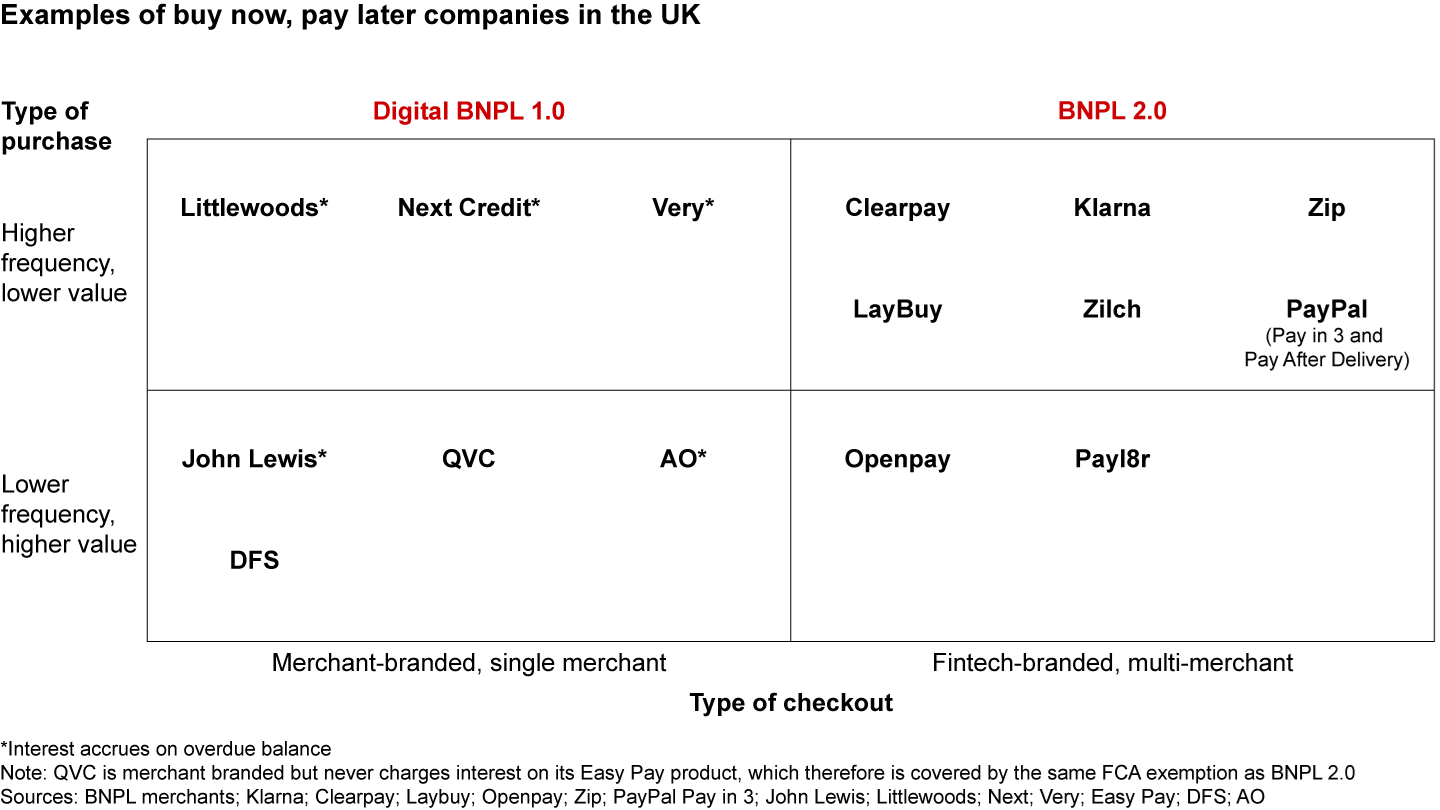
What we do not show in Figure 2 are the white-labeled solutions offered by Creation, NewDay, Barclays, V12, and others. The business model around white-labeling consumer finance products does not fit our definition of BNPL 1.0 or BNPL 2.0. Nevertheless, it offers an interesting embedded finance opportunity. Embedding financial products at the point of customer need—distributed via brands, including retailers that customers have strong relationships with—is garnering a lot of interest. If banking providers can successfully execute white-labeled BNPL and other lending products, they may be able to significantly scale up distribution of their products.
Besides well-established white-labeled providers such as Barclays and NewDay, another notable provider is Divido, with a slightly different offering; it combines BNPL white-labeled solutions with a marketplace for lenders to provide financing to retailers at competitive rates. On occasion, these white-labeled providers do offer true BNPL 2.0 solutions—installment loans that are completely interest-free—but interest-bearing financing is more common. White-labeled, large retailer-branded financing works for a key customer segment: shoppers without strong direct relationships with independent brands. Here, these large retailers have maintained a key advantage in being the point through which shoppers discover and purchase items.
It comes as no surprise, then, that BNPL 2.0 providers are also encroaching on the realm of online retail. BNPL 2.0 apps are beginning to act as aggregators where customers search for and buy from different merchants simultaneously, thereby taking control of more of the customer journey. Clearpay, Klarna, Zip, and Laybuy have launched their own apps where users can search, discover, and finance purchases in one interface. Some BNPL 2.0 providers also offer interest-bearing products for high-ticket purchases, though the sequence of product releases varies.
For example, PayPal is rapidly extending its credit products within the e-commerce space. It has gone from being a digital wallet to offering Pay After Delivery (payment 14 days after the purchase date), followed by PayPal Credit (revolving credit with offers), followed by Pay in 3 (payment in three, zero-interest installments). On the other hand, some BNPL 2.0 providers have moved into longer-term, larger-ticket financing. These products accrue interest, so they’re already regulated and fall outside our definition of BNPL 2.0.
Comparisons to cards and digital wallets
These days, when shoppers go to check out, they often see the same options: pay with card, credit or debit; pay via a digital wallet, such as PayPal or Apple Pay; or pay with BNPL. These payment products are distinct, but increasingly overlap.
“We’ll never not have a card option, we’ll never not have PayPal, we’ll never not have BNPL.” — senior executive, fashion retailer
Dissecting BNPL products in the UK
With about £100 billion in sales in 2020, the UK ranks as the world’s third largest e-commerce market. Growing about 70% from 2019, BNPL contributed roughly 5% of this transaction volume, Worldpay estimates. This level of BNPL penetration within e-commerce exceeds that of younger markets, such as the US (at about 2%), but falls well below other Western European countries, including Sweden (23%) and Germany (19%), as well as Australia and New Zealand (10% each). At first glance, then, BNPL might seem like a fringe product in Britain.
The picture differs when looking at customer penetration, instead of transaction volume. Our survey found that about 25% of 18-to–74-year-olds paid with BNPL at least once in 2021. This is higher than the 20% usership reported by a March 2021 Capital Economics survey, but is consistent with what major providers reported in our interviews. Therefore, many people shop with BNPL, but much less frequently than with mobile wallets or cards, as validated by our survey data (see Figure 3 and Figure 4). This isn’t surprising for an emerging product and explains why total transaction values appear comparatively small.
Buy now, pay later and credit cards in the UK vary on a number of dimensions

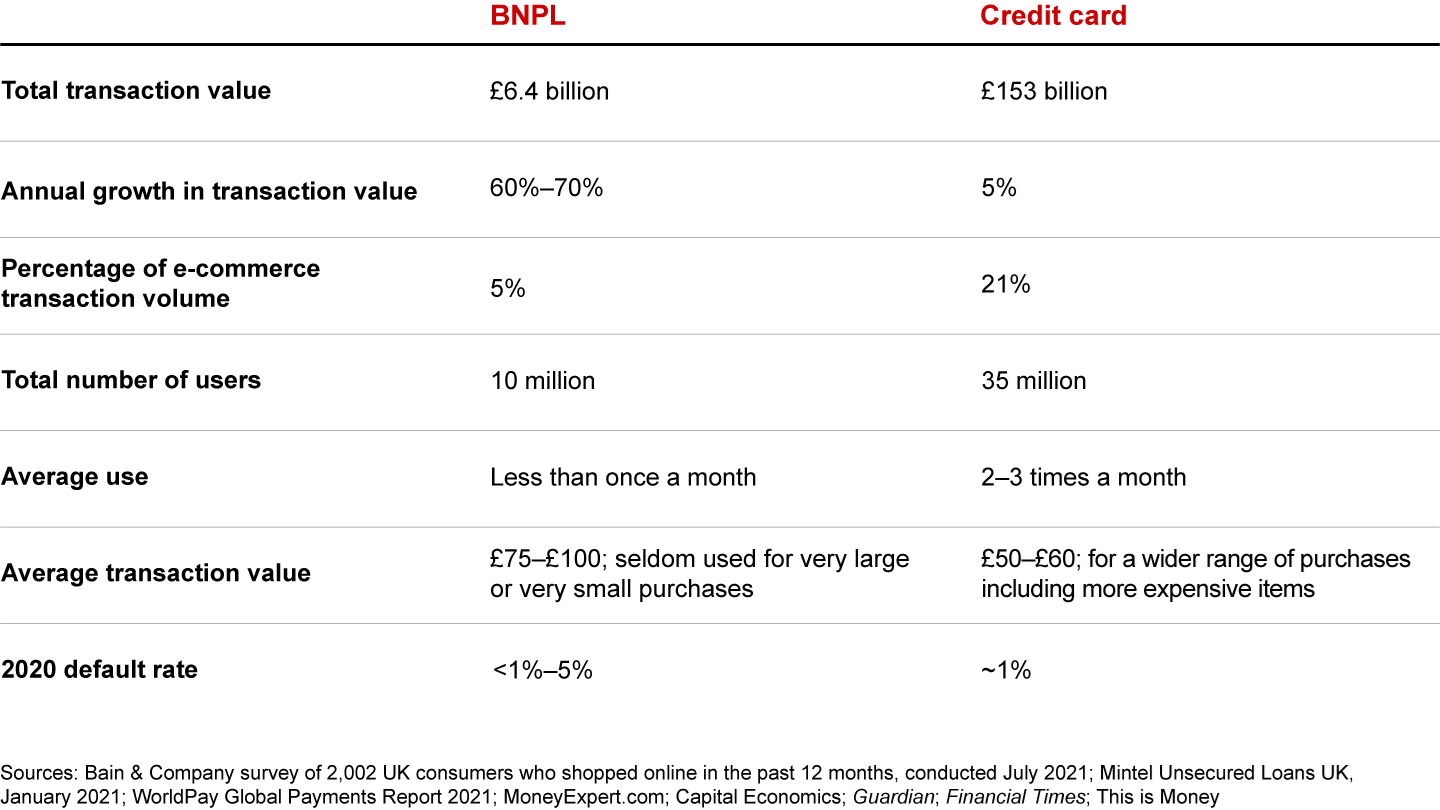
Comparing buy now, pay later with other forms of unsecured lending

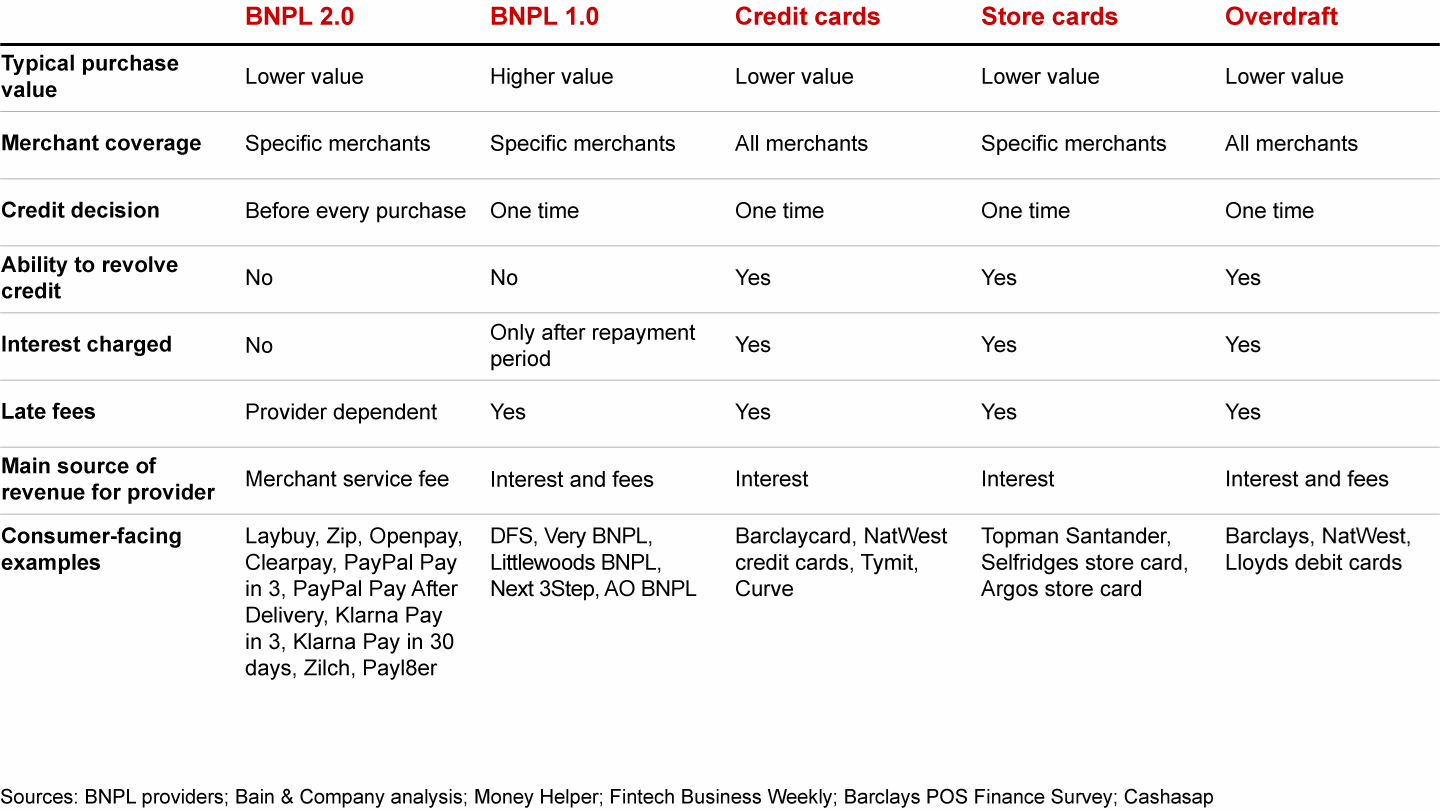
What could this mean for e-commerce payment volumes over the next few years? Even if BNPL companies don’t attract any more customers, as they partner with more merchants, develop their aggregator apps, offer merchant-agnostic payment solutions (in which BNPL companies shift focus from the merchant to the end-customer relationship), and refine omnichannel services, purchase frequency could increase and the proportion of e-commerce transactions that are BNPL would follow in kind. As a result, that 5% of transaction volume could move closer to the 25% in penetration in the coming years.
Embedded e-commerce checkout services at the core
Given the size of the opportunity, the rush to participate and even lead in this market makes sense. Six companies make up the lion’s share of BNPL transactions in the UK. Most of them began with an embedded e-commerce checkout product that allows users to spread out payments. Their operating models, however, vary in omnichannel capabilities, credit approval processes, and application of late repayment fees (see Figure 5).
Many companies enjoying growth
Indicative of the health and growth potential of the market, BNPL providers are expanding beyond simply offering an embedded checkout button. Most, for instance, have introduced proprietary mobile applications that help customers search and discover products to buy. By aggregating e-commerce offerings in a single interface, these apps support more stages of an online purchase. Apps from Klarna, Zilch, and Laybuy go a step further, integrating a virtual prepaid card that links to the user’s account and works with any merchant online. This means that when BNPL providers cannot offer an embedded finance service, they are able to deploy a direct-to-consumer proposition instead.
In addition, with the Laybuy and Zilch virtual cards, consumers can delay payment on in-store purchases as well. Many of the BNPL providers are also finding ways to support merchants with in-person sales. Typically, they’ve integrated with the merchants’ in-store POS systems, allowing shoppers to pay using a QR code or bar code. One merchant we spoke with discussed reimagining the customers’ journey so that sales reps could convert a sale on the shop floor using BNPL on their phone or tablet. This would be a radical, but feasible, redesign of the in-store experience.
Credit assessment and underwriting
BNPL providers have also innovated to develop their own credit assessment process. Credit underwriting for BNPL companies balances two often opposing priorities. First, companies must build relationships with customers and strive to delight them. When we surveyed more than 600 people who had used BNPL in the previous six months, only 8% expressed a preference for a traditional alternative, such as a credit card. This marks a shift in perception and behavior brought about by reinventing how people shop, making credit accessible to more people and with much faster approval times.
The second priority involves the need to share information in a centralized way, in order to protect customers from debt spiraling across multiple providers. Existing data-sharing mechanisms and credit-scoring models provided by credit reference agencies (CRAs) were designed for traditional credit products. Participating lenders typically share static data monthly, and not all share the same borrower details. For example, default-only subscribers share information only on accounts in default, whereas full subscribers provide all of their borrowers’ data, including repayment history.
Such frameworks suit an up-front credit check toward a larger credit limit that’s underwritten only once and are designed for longer-term borrowing (typically more than a year). However, they don’t work for BNPL, where consumers take small amounts of credit for much shorter periods of time. CRAs are working with BNPL companies to find ways of ingesting these usage patterns and the associated credit information into their databases.
BNPL companies have worked around this challenge through several innovative underwriting approaches. Many invest in aggregating their own users’ data to build proprietary credit information and assessment models. This enables them to underwrite credit and assess spending limits in real time, reducing the need for a front-loaded approval process akin to credit cards.
Companies with more customer data can manage credit risk independently. By relying on their data sets, they can extend credit to new and underserved customers based on proprietary credit assessments. A certain level of defaults is factored into their customer acquisition costs, especially during earlier stages of adoption. A small upper limit for a first purchase is extended to all users, often with only a soft credit check, in order to start seeding these proprietary data sets. BNPL providers have succeeded in managing risk this way, with larger firms such as Klarna and Clearpay saying they see default rates of less than 1%, but smaller firms having rates that can reach to around 5%.
The unresolved challenge of sharing credit data among providers
One problem remains, though; namely, a lack of strong mechanisms for BNPL companies to share data with each other (and with traditional lenders). At the moment, BNPL companies are able to share data only on missed payments and defaults—events that occur too late in a user’s journey to effectively protect against misuse. They’re unable to piece together customers’ cumulative balances across providers.
Some companies mitigate this challenge by conducting credit checks using reports provided by CRAs. There are two types of credit checks. The first type, known as “soft” credit checks, doesn't adversely affect the user’s credit score, and is common among BNPL providers. CRAs don’t mark such checks as a formal application for credit visible to other lenders, thereby minimizing any effect on the user’s future ability to borrow. The downside with soft checks is that the information isn’t made available to other providers.
The second type of credit check, called “hard” credit checks, does allow lenders to comprehensively share credit information with CRAs. However, these types of checks are unsuitable, even detrimental, for BNPL users, because each hard credit check leaves a credit application footprint on customers' profiles that can adversely affect their credit score. Where users make smaller, less frequent purchases, the negative effect can be disproportionate and persist for months, despite timely repayments.
Many BNPL providers thus don’t conduct hard checks on their customers. Laybuy and Openpay are the only companies that perform hard searches as part of their underwriting process, and they search only once when a customer opens a new account, or when a customer requests a higher spending limit. A number of other BNPL providers and CRAs are exploring how more comprehensive data sharing might work. It will take a lot of data for the CRAs' scoring models to know how BNPL behavior, such as a missed payment, should affect the consumer’s credit score. Consequently, the data and infrastructural challenges are significant, and developing scalable solutions could take a few years.
How then might BNPL companies and CRAs work more closely in the future? We see a few promising paths. First, data-sharing mechanisms should become more inclusive of thin-file customers. This includes not just younger individuals, but also those with a limited credit history because they’re new to the UK or simply haven’t wanted a credit card or loan in the past. Reforms should take into account the proprietary nature of customer data, and not encumber their ability to monetize this data. CRAs can also help educate other types of institutions—mortgage lenders, for example—on fairly assessing the impact of BNPL debt on a user’s overall creditworthiness.
Second, credit-scoring methods should adjust for the short-term, lower-value nature of BNPL balances. Frameworks and infrastructure that cater to the particulars of BNPL products will be instrumental to fostering collaboration. Lastly, open banking regulations could enable BNPL companies to work with CRAs and banks to help customers build their credit profiles. Klarna and others are exploring possible solutions with the recent launch of their open banking platforms in the UK. New credit bureaus have also stepped up. Credit Kudos, for instance, has partnered with BNPL start-up Zilch to offer open banking affordability assessments on users.
With appropriate systems and incentives in place, BNPL companies will be able to help consumers with no credit file, or a thin one, to access the broader credit ecosystem. The vast majority of consumers make timely repayments; 69% of users we surveyed said they had never missed a payment. This data supports the goals of building their credit profiles and unlocking access to other financial services. Indeed, of the more than 400 BNPL users under age 45 in our survey, two-thirds wanted their BNPL usage to contribute toward their credit score, so BNPL providers have a unique opportunity to build this into their service offering.
Of the more than 400 BNPL users under age 45 in our survey, two-thirds wanted their BNPL usage to contribute toward their credit score.
The user profile
Recall our estimate that in the last year, 10.1 million people used BNPL in the UK. Based on this and other survey data, BNPL has become a mass-market product, though there are some interesting trends to observe. Throughout this report, we compared BNPL with credit cards because they share many of the same use cases and are seen by many as alternatives to each other. While credit cards still dominate across generations, the data points to younger, digital-native consumers increasingly adopting BNPL over credit cards (see Figure 6). Based on what we know about BNPL and demographic changes, the following may explain the preference: young people are attracted to digital-first services, are more engaged with lifestyle-oriented products, and are more averse to traditional credit.
While buy now, pay later is most popular with younger consumers, it also appeals to many older ones as well

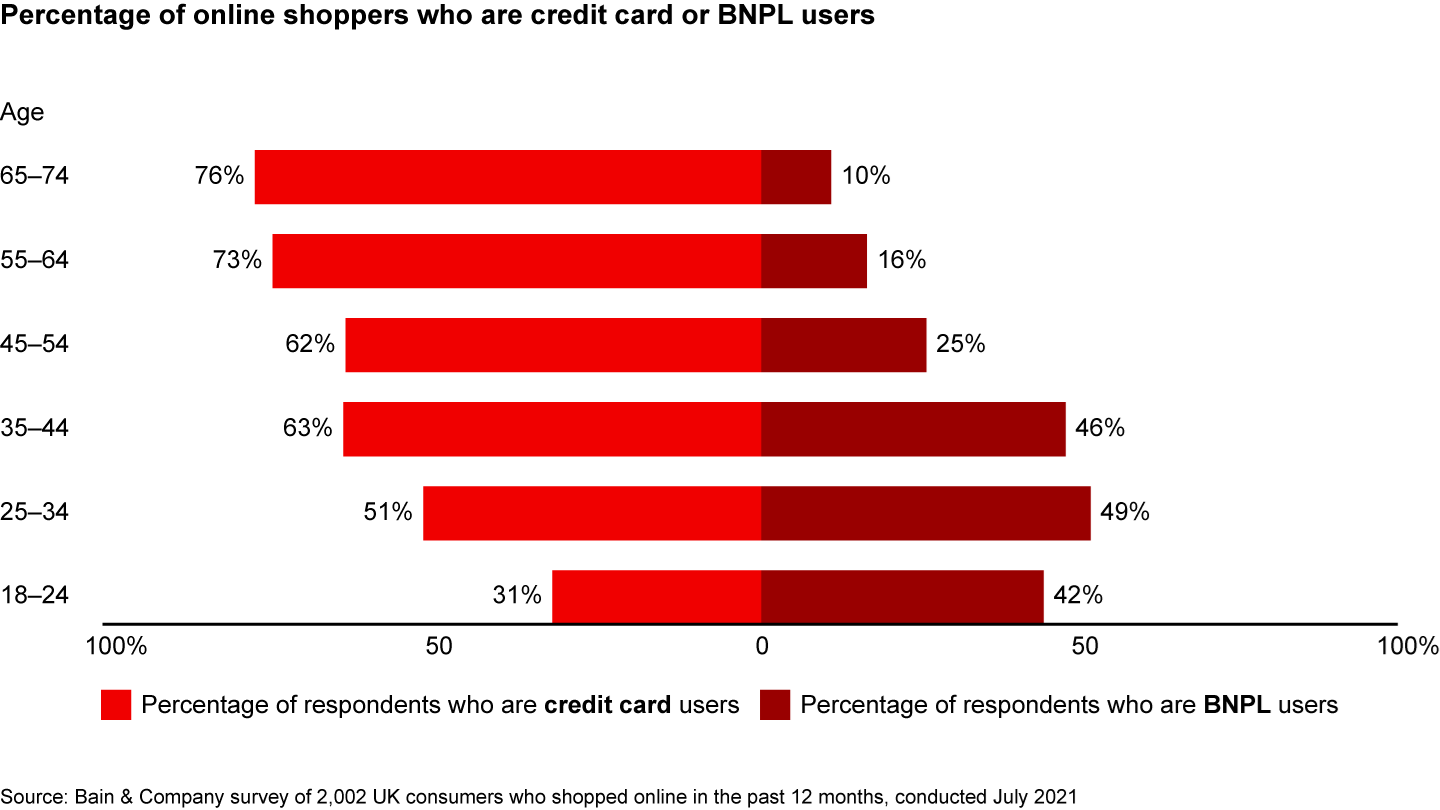
Though BNPL is popular with young people, it also has broader appeal. Our survey found BNPL adoption was highest among respondents aged 25 to 34, and significant even for those in the 45-to-54 cohort. Some 68% of people who used BNPL in the previous six months also have access to a credit card (compared with 62% across the entire sample), suggesting significant penetration among people with prime and near-prime credit profiles. We found BNPL usage was relatively consistent across household income levels, and for men and women.
68% of online shoppers who used BNPL in the past six months also have access to a credit card.
Only 3% of those who used BNPL described their financial situation as vulnerable, while 35% indicated they have little to no savings every month. This is broadly in line with the overall population of online shoppers. We found that 63% of BNPL users are in full-time employment, meaning they are nearly 29% more likely to be in full-time employment than all respondents to the survey. In addition, it is worth noting that more than 40% of users have a university or higher level of education.

Younger people tend to use BNPL products for smaller, higher-frequency purchases, whereas older consumers turn to it for larger items (see Figures 7 and 8). Across all age groups, a majority of BNPL users use it less than once a month and for purchases under £100 in value. By comparison, the average credit card in the UK is used two or three times a month, with an average value of £50 per transaction. Users also buy a wide range of products. When asked what types of purchases they used BNPL for, the most frequent answers were in the categories of clothing and shoes (45%), electronics (43%), and home and garden (28%).
Young consumers using buy now, pay later tend to buy low-priced items

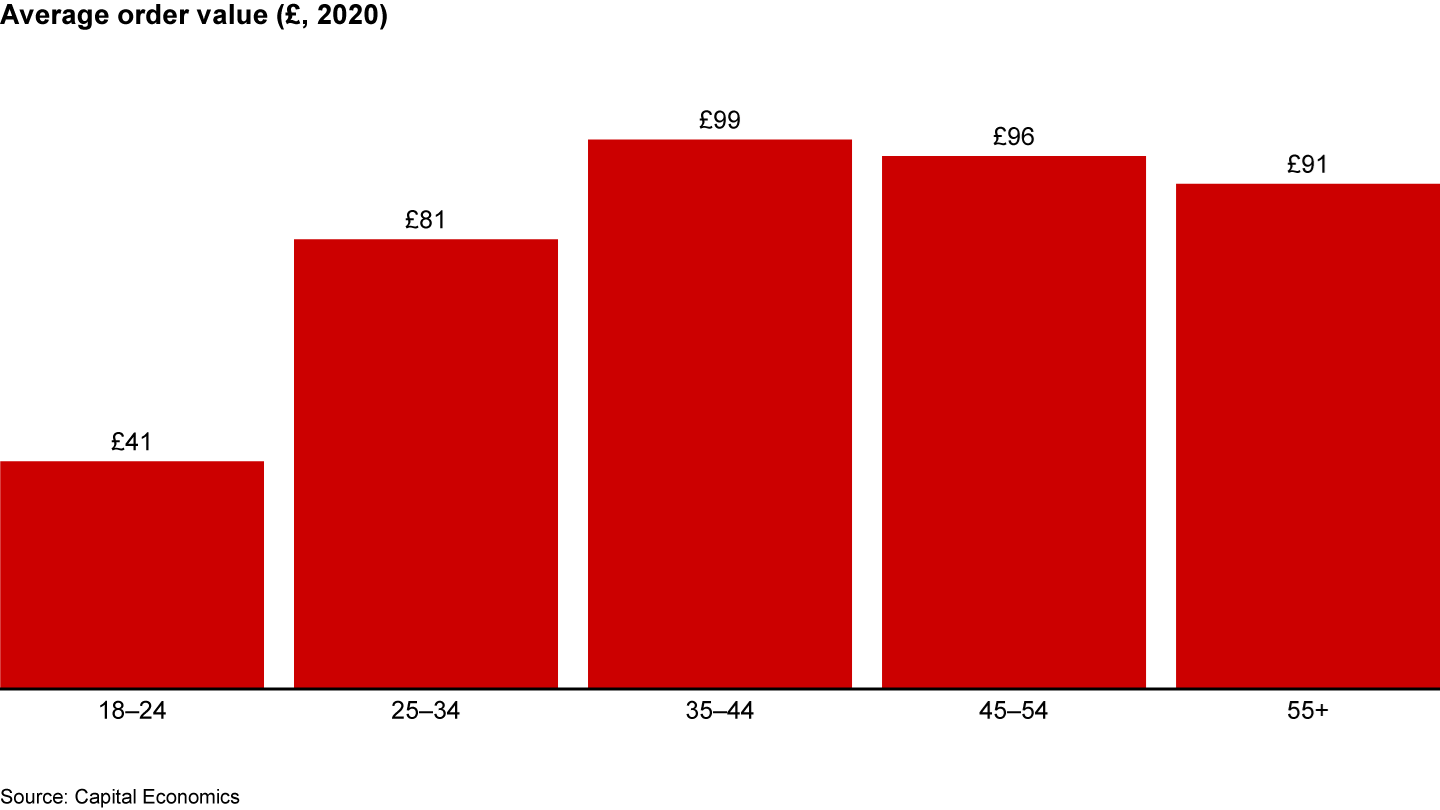
Younger consumers use buy now, pay later more frequently

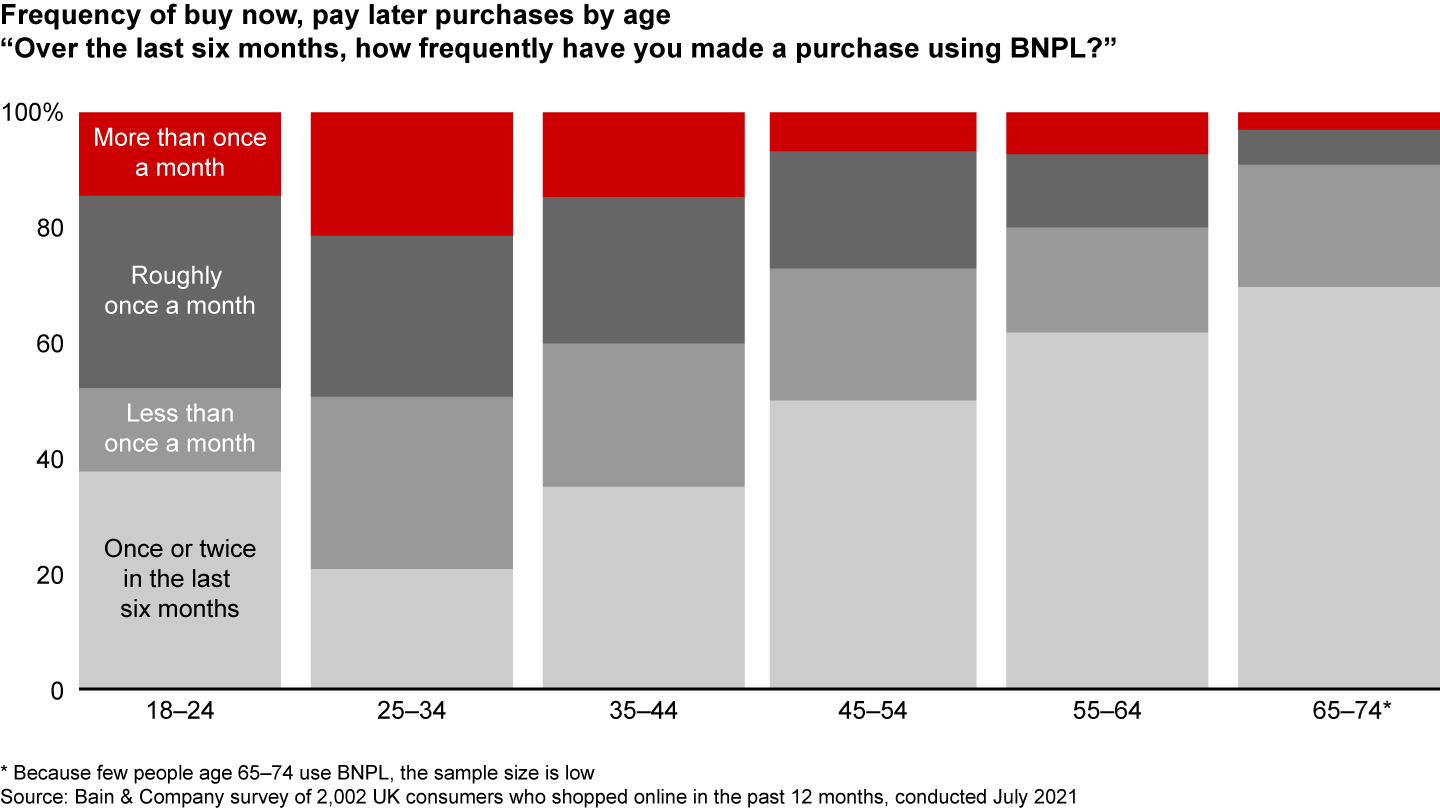
Finally, adoption spans the socioeconomic and demographic spectrum—it isn’t confined to the financially vulnerable—and many users have access to other forms of credit (see Figure 9).
The financial situation of buy now, pay later users resembles that of other consumers

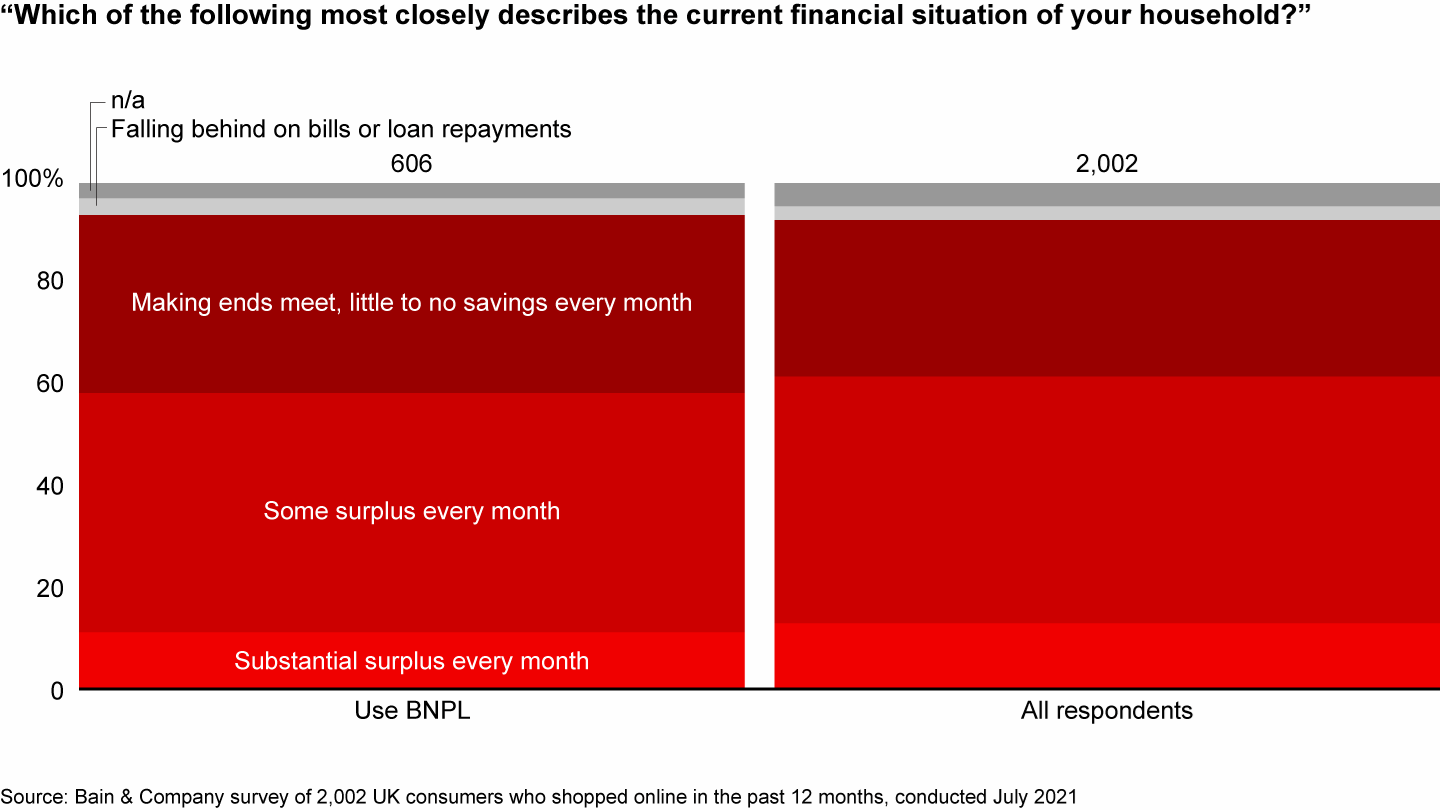
Deconstructing the two BNPL 2.0 business models
There are two versions of the BNPL economic model, each consisting of three main parties: end customer, merchant, and acquirer. The customer pays no interest or fee (with the exception of late-payment penalties from some providers). Instead, merchants pay the BNPL provider a service fee, which isn’t visible to the consumer. Part of the customer appeal of these offerings has been their simple and transparent nature, the absence of hidden fees common in other forms of unsecured lending, and the fact that all consumers get the same repayment terms if they’re accepted, without higher fees or APRs for those deemed higher-risk borrowers. Similarly, merchants see benefits in the form of increased online sales, higher conversion rates, and new customers.
Credit typically relies on the balance sheet of the BNPL provider, as part of the two basic business models, the most prevalent being embedded in an e-commerce website, the other being merchant agnostic (see Figure 10).
There are two basic business models for buy now, pay later 2.0

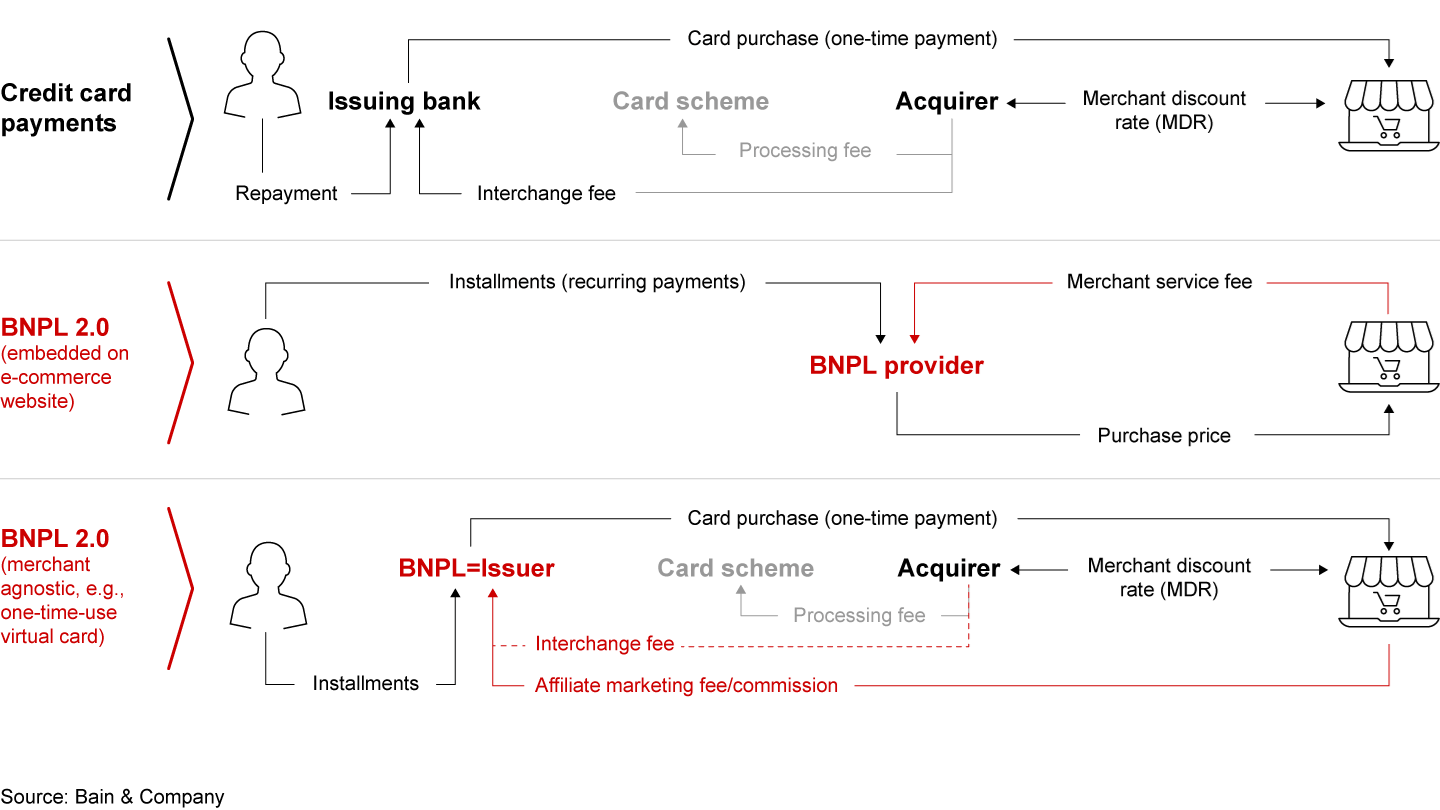
In the embedded model, the provider acts as intermediary between merchant, acquirer, and customer. The ability to aggregate demand enables the provider to negotiate lower acquirer discounts than individual merchants can. Simultaneously, merchants pay the provider a higher service fee in return for the embedded credit service and its ability to lift commercial metrics such as traffic, conversion rates, and AOVs.
The merchant-agnostic model has quickly gained ground. Proprietary apps and web platforms combine the roles of e-commerce aggregator and affiliate marketer, allowing users to apply BNPL to any purchase, independent of the merchant. They do this by issuing a virtual card or similar payment tool directly to the customer, replicating the cash flows of an embedded BNPL loan. Instead of a typical service fee, providers seek to charge merchants an affiliate commission or an interchange fee (although statutory caps on interchange fees mean this will not likely be a key component of the transaction economics). Prominent affiliate marketing networks have already partnered with BNPL firms in the UK to enable this merchant-agnostic model. Notably, Rakuten, Awin, and Sovrn have all partnered with Laybuy to give customers access to more than 5,000 merchants in the UK.
The next section of the report delves into consumer and merchant experiences of using BNPL. We evaluate criticisms of BNPL by viewing them through a customer lens, based on research with both consumers and merchants that illuminates the benefits and challenges of using these services.
Net Promoter®, NPS®, and the NPS-related emoticons are registered trademarks of Bain & Company, Inc., Satmetrix Systems, Inc., and Fred Reichheld. Net Promoter Score℠ and Net Promoter System℠ are service marks of Bain & Company, Inc., Satmetrix Systems, Inc., and Fred Reichheld.